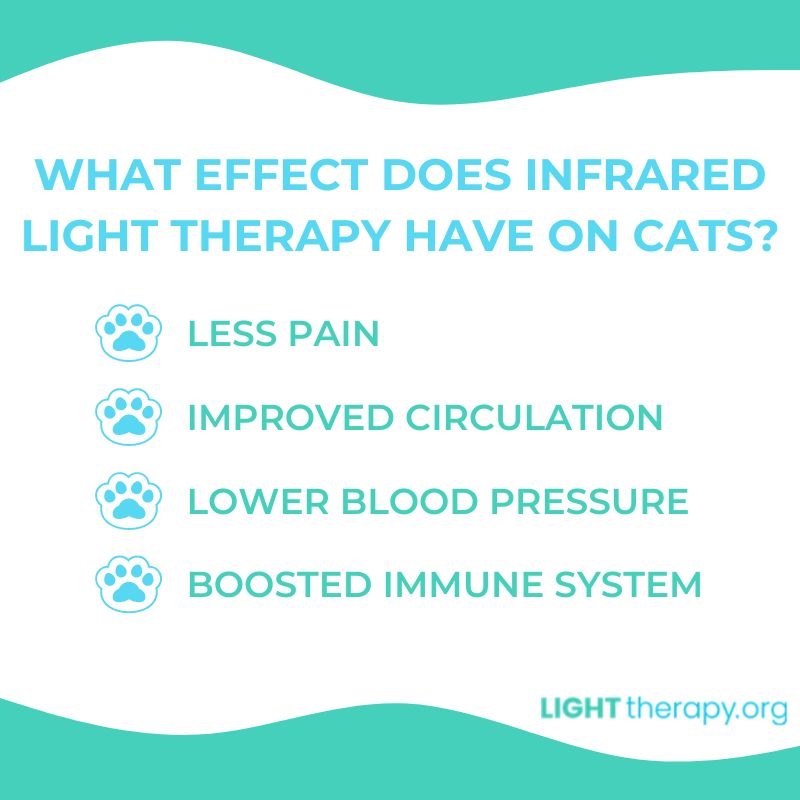Infrared Light Therapy for Cats: Everything You Need to Know
Everyone understands dog people — dogs are affectionate, loving, playful, intuitive, and above all, loyal. It’s easy to see why so many people across the world would do anything for their canine companions.
Cat people, on the other hand, are a little more complicated. Unlike a dog, your cat probably doesn’t treat your whole family like her pack. And while fiercely intelligent, most cats won’t use their smarts to learn tricks. They’ll use them to get more snacks, sneak into places they’re not allowed, and get attention — but only on their terms.
Cat people will tell you these are precisely the reasons why they love their cat so much. If this sounds like you, then you’re probably willing to do anything to help your cat. Your cat is a member of your family, and watching your favorite feline suffer is not an option.
If this is the position you’ve found yourself in, look no further. Read on to learn more about how infrared light therapy for cats may be the key to your cat’s health and happiness.
Red Light vs. Infrared Light
While it may sound like “red light” and “infrared light” can be used interchangeably, there are some key differences that are very important in classifying these powerful types of light.
Wavelengths of light are part of a spectrum, and they are measured in nanometers (nm), which are one billionth of a meter — very small! Red light is part of the visible light spectrum, and its wavelengths measure from 630 to 700 nm.
Even though it’s next to red light on the light spectrum, infrared light is invisible to the naked eye. Its wavelengths measure 800 to 1000 nm. A key benefit of infrared light in light therapy is that it can penetrate the skin’s surface up to 1.5 inches — much deeper than red light and providing more clinical benefits than red light alone.
What Is Light Therapy?
Light therapy uses different wavelengths of light to treat many common health problems, including chronic pain, common skin conditions such as eczema, joint problems, and perhaps certain more serious diseases. Devices used for home light therapy feature light-emitting diodes, or LEDs, that penetrate your skin with healing results.
The same principles behind light therapy for people can also be applied to light therapy for cats. Although it’s been studied much more in humane subjects, veterinary medicine is catching up to the many benefits of light therapy for animals.
Infrared Light Therapy for Cats

When it comes to infrared light therapy for cats, there hasn’t been much meaningful research yet. Some studies have been conducted to determine the efficacy of light therapy in treating common health conditions in dogs, and these studies have yielded positive results. And there’s quite a bit of research on the effects of infrared light therapy to treat us humans.
Assuming cats aren’t all that different from dogs and humans, at least with respect to how light wavelengths affect their cells, we can also assume infrared light therapy for cats would be a similarly effective treatment option for your feline.
Some of the most common uses of infrared light therapy for animals include treating pain and promoting healing. The pain could be muscular or skeletal, or you may be treating a skin condition, such as an allergic reaction or bacterial infection. Some believe infrared light therapy may be effective for treating chronic conditions like kidney disease, which is very common in cats, especially senior cats.
Why Infrared Light?
What are the benefits of infrared light over other wavelengths of light when it comes to treating your cat? It has to do with the greater length of those higher infrared wavelengths.
As of this writing, we found no studies that focus solely on the benefits of infrared light therapy for cats, as most studies in animals focus on lower-wavelength light in general. However, studies such as this one have found that higher wavelengths of invisible of light penetrate deeper into the body. This makes infrared light a better option for treating conditions that affect your cat’s internal structure — like bones, muscles, tendons, ligaments, joints, or organs.
There are other possible benefits to infrared light therapy. The mitochondria of your cat’s cells will absorb the infrared light, and this added energy will help promote healing. Your cat may experience less pain, along with improved circulation, lower blood pressure, and a boosted immune system. Your kitty may even seem more relaxed.
Next Steps on Infrared Light Therapy for Cats
Before you start shopping around for in-home infrared light therapy devices for your cat, be sure to speak with your veterinarian.
Your vet knows your cat’s full medical history and can help you determine a treatment regimen that’s tailored to your feline friend. Light therapy may be helpful, but it should not replace prescribed medications without the guidance of your vet.
Many veterinary offices are starting to offer certain kinds of light therapy for cats. But because infrared light therapy is still a new technology that hasn’t been thoroughly tested in official clinical trials, your vet may not agree that it’s a viable treatment option for your cat.
While you should always listen to your vet’s advice, be prepared to advocate for your cat or ask for a second opinion if you feel strongly about trying infrared light therapy, or another form of light therapy, for your cat.